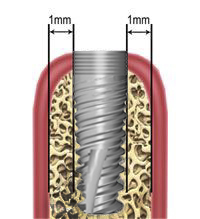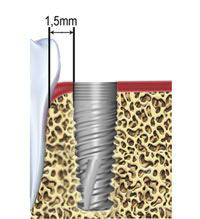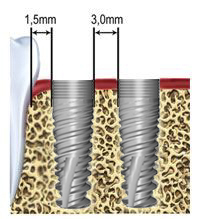No products
To be determined
Shipping
0,00€
Total
Product successfully added to your shopping cart
Quantity
Total
There are 0 items in your cart.
There is 1 item in your cart.
Total products
Total shipping
To be determined
Total
The right size of dental implant is the key to long-term osseointegration
Every day, implant surgeons think about the right implant diameter to be used in a particular situation. What are the choice criteria? Sizes of implants have biomechanical and clinical significance.

Biomechanical patterns
1. The longer the implant is the greater integration with bony tissue it features. This allows heavier functional load on the implant and surrounding osseous tissue.
2. Larger implant's diameter promotes better load distribution in surrounding bone tissue and higher strength.
Thus, size, diameter and length of the implant are to be as great as practicable, from the points of view of both biomechanical and clinical effectiveness.
However, size of the implant is significantly constrained by jaw dimensions, as well as other anatomical structures of maxillo-facial area. In addition, to ensure adequate osseogenesis the implant is to be all round surrounded with bone, which thickness is over 0.75-1.0 mm.
Thus, from biological and clinical points of view the implant dimensions are to be small enough to be all round surrounded with a bone mass, which provides adequate osseogenesis.
Bone volume strongly determines diameter and size of the implant
The implant is to be all round surrounded with bone, which thickness is more than 1 mm. Otherwise, bony tissue that surrounds the implant loses its ability to adequate osteogenesis and turn resorbable. This leads to formation of fibrous or granulation tissue around the implant.
In case bone thickness between the implant bed and its outer edge is less than 1 mm, there is a threat of formation of a compact necrotic zone and loss of viable bone layer, which provides osteogenesis. Implant placing requires both certain bone thickness and height.
Implants and neighboring teeth, as well as implants against each other, are to be divided with a bone layer, which thickness is not less than 1.5 mm. The rule is based on necrotic zone width after atraumatic bone dissection.
Anatomical parameters and spatial proportions

Pic.1 Bone depth from the side of cortical plate - not less than 1 mm.

Pic.2 The distance between an implant and a tooth root must be 1.5 mm at the minimum, i.e. the distance from the center of the bed to the neighbor tooth must be about a diameter of the implants body + 1.5 mm.

Pic.3 The distance between two implants must be: a sum of diameters of installed implants bodies + 3 mm the distance between implants
1. Within the first phase, the distance between the two teeth can be determined by the gap width. Depending on the tooth shape, the gap width is 1.0 mm (2x0.5 mm) smaller than the distance at the bone level. (pic.1)
2. In medio-distal direction at the bone level, the distance from the implant neck shoulder to the adjacent tooth is equal to 1.5 - 2.0 mm (pic.2)
3.The rule is basic for calculation of bottom gap width value, for respective types of implants.
Example: implant neck shoulder Ø 4.8 mm + 2x1.0 mm ≥ 6.8 mm - minimal gap width.
Anatomic limitations are dependent on both quantity and quality of preserved bone. All these factors determine ways to resolve emerging problems.
Table 1. Medial-distal (MD) diameter of the upper jaw teeth in the crown and root area, and recommended implant diameter
|
|
MD diameter crown
|
MD diameter CEJ
|
MD diameter CEJ - 2mm
|
Recommended implant
|
|
Central
|
8,6
|
6,4
|
5,5
|
4,2 - 5,0
|
|
Lateral
|
6,6
|
4,7
|
4,3
|
3,3 - 3,75 - 4,2
|
|
Pointed tooth
|
7,6
|
5,6
|
4,6
|
4,2
|
|
1st premolar
|
7,1
|
4,8
|
4,2
|
4,2
|
|
2nd premolar
|
6,6
|
4,7
|
4,1
|
4,2
|
|
3rd molar
|
10,4
|
7,9
|
7,0
|
4,2 - 5,0
|
|
2nd molar
|
9,8
|
7,6
|
7,0
|
4,2 - 5,0 - 6,0
|
Table 2. Medial-distal (MD) diameter of the lower jaw teeth in the crown and root area, and recommended implant diameter
|
|
MD diameter crown
|
MD diameter CEJ
|
MD diameter CEJ
|
Recommended implant
|
|
Central
|
5,3
|
3,5
|
3,5
|
3,3 - 3,75
|
|
Lateral
|
5,7
|
3,8
|
3,5
|
3,3 - 3,75
|
|
Pointed tooth
|
6,8
|
5,2
|
4,1
|
4,2
|
|
1st premolar
|
7,0
|
4,8
|
4,5
|
4,2
|
|
2nd premolar
|
7,1
|
5,0
|
4,7
|
4,2
|
|
1st molar
|
11,4
|
9,2
|
9,0
|
4,2 - 5,0
|
|
2nd molar
|
10,8
|
9,1
|
8,5
|
4,2 - 5,0 - 6,0
|
Indications small diameter implants
1. Thin edge of crestal bone.
2. The need to obtain a low emergence profile in the course of prosthetic repair of lower incisors, upper lateral incisors and, in some cases, upper and lower premolar's.
Indications for implants with a diameter of 3.1 mm
1. As intermediate supports in fine crestal bone.
2. As single supports in the course of prosthetic repair of lower incisors and upper lateral incisors; feature sufficient mechanical strength, therefore additional implants are not required.
Indications for implants with a diameter of 3.3 mm
1. Same as with 3.1 mm.
2. Suitable for placing in a thin edge of crestal bone.
3. Prosthetics of single defects of tooth alignment.
Indications for implants with a diameter of 3.5 - 3.75 mm
1. Prosthetics of single defects of tooth alignment.
2. As a support for bridge construction in fine edge of crestal bone and necessity of low emergence profile.
The difference from 3.3 mm implants
1. Larger diameter increases the surface of osseointegration.
2. Better load distribution at high biomechanical requirements.
3. Higher resistance at low bone density and simultaneous implantation.
Post-extraction prosthetic repair of lower incisors is optimal. Reliable fixation allows immediate loading. The implant diameter is necessary to provide narrow emergence profile with sufficient crestal bone thickness, like prosthetics of molars.
Indications for implants with a diameter of 4.2 - 5.0 mm
1. Prosthetic repair of single dentition defects in multi-rooted teeth.
2. Implantation under sufficient crestal bone thickness.



